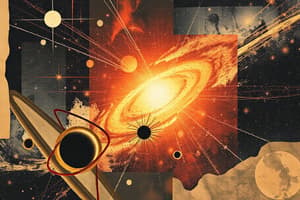Podcast
Questions and Answers
Who proposed the Big Bang Theory?
Who proposed the Big Bang Theory?
George Lemaitre
What debunked the Steady State theory?
What debunked the Steady State theory?
- String Theory
- Cosmic microwave background (correct)
- Galaxies moving away
- Abundance of light elements
What does M-Theory suggest about the origin of the universe?
What does M-Theory suggest about the origin of the universe?
Contact of two hyperdimensional branes
What does String Theory suggest about the construction of the universe?
What does String Theory suggest about the construction of the universe?
What was Descartes' Vortex Theory about?
What was Descartes' Vortex Theory about?
What did Kant-Laplace Nebular Theory claim about the formation of the solar system?
What did Kant-Laplace Nebular Theory claim about the formation of the solar system?
The Solar Nebular Theory is considered the most convincing theory for the formation of the solar system.
The Solar Nebular Theory is considered the most convincing theory for the formation of the solar system.
Ceres is a _____ known asteroid that became a dwarf planet.
Ceres is a _____ known asteroid that became a dwarf planet.
What causes comets to become active?
What causes comets to become active?
Which layer of Earth is the thickest?
Which layer of Earth is the thickest?
What are the four subsystems of the Earth?
What are the four subsystems of the Earth?
The outer core of the Earth is solid.
The outer core of the Earth is solid.
Study Notes
Theories on the Origin of the Universe
-
Big Bang Theory: Proposed by George Lemaitre; suggests the universe began from a singularity—an infinitely small, dense, and hot entity.
-
Evidence for Big Bang: Galaxies are moving away, cosmic microwave background radiation exists, and light element abundance supports this theory.
-
Steady State Theory: Proposed by Herman Bondi, Thomas Gold, and Fred Hoyle; posits that although the universe is expanding, matter density remains constant.
-
Counter Evidence: Discovery of cosmic microwave background radiation refutes this theory, showing the universe is not compositionally constant.
-
M-Theory: Proposed by Stephen Hawking and Leonard Mlodinow; suggests the universe’s origin occurs through the interaction of two hyperdimensional branes.
-
Connection to String Theory: It supports concepts of sheets or branes integral to understanding the universe's structure.
-
String Theory: Introduced by Gabriele Veneziano; describes the universe as composed of tiny vibrating strings, smaller than subatomic particles.
-
Evidence: Combines principles of general relativity with quantum mechanics, offering a framework for understanding particle physics.
Theories on the Origin of the Solar System
-
Descartes’ Vortex Theory: Proposed by Rene Descartes; suggests solar system bodies formed from whirlpool-like motions of pre-solar materials.
-
Planetary Formation: Primary whirlpool motion creates planets; secondary motion forms satellites.
-
Buffon’s Collision Theory: Introduced by George-Louis Leclerc, Comte de Buffon; proposes planets formed from debris resulting from a collision between the sun and a giant comet.
-
Limitations: Fails to account for the unique positions of planets' orbits.
-
Kant-Laplace Nebular Theory: Proposed by Immanuel Kant and Pierre-Simon Laplace; asserts the solar system formed from a nebula of dust and gas approximately 4.5 billion years ago.
-
Jeans-Jeffreys Tidal Theory: Suggested by Sir James Hopwood Jeans and Harold Jeffreys; proposes planets form from substances ejected from the sun due to a massive star’s approach.
-
Solar Nebular Theory: Propounded by Emanuel Swedenborg; considers the solar system's formation from a collapsing interstellar gas and dust cloud.
-
Protostar Formation: Results from compressing the center, with the sun and planets forming from surrounding materials.
Celestial Bodies in the Solar System
-
Asteroids: Small rocky bodies located mainly in the asteroid belt between Mars and Jupiter; Ceres is the first known asteroid, now classified as a dwarf planet.
-
Near-Earth Asteroids: Can be pulled from the main belt and approach Earth.
-
Comets: Composed mainly of ice and gases; become active near the sun, leading to the formation of vaporous jets.
-
Origin Sources: Short-period comets like Halley's comet come from the Kuiper belt, while the Oort Cloud, farther away, remains largely unexplored.
-
Meteoroids: Debris and remnants from comets and asteroids; they glow when entering the atmosphere, creating meteor trails known as shooting stars.
-
Dwarf Planets: Defined by the International Astronomical Union (IAU) in 2006; these objects orbit the sun, maintain a spherical shape due to gravity but cannot clear their orbital paths.
-
Examples: Makemake, Haumea, Ceres, Eris, and Pluto.
Earth Subsystems
-
Earth's Layers: Composed of the inner core (solid), outer core (liquid), mantle (divided into lower and upper), and crust.
-
Mantle Characteristics: The lower mantle exhibits plasticity, while the upper mantle and the crust form the lithosphere.
-
Crust Composition: Divided into continental and oceanic crusts, the lithosphere's surface.
-
Subsystems of Earth: Includes lithosphere, atmosphere, hydrosphere, and biosphere.
-
Plate Tectonics: Movement of lithospheric plates, integral to understanding geological processes.
Studying That Suits You
Use AI to generate personalized quizzes and flashcards to suit your learning preferences.
Related Documents
Description
Explore the various theories surrounding the origin of the universe, including the Big Bang Theory, Steady State Theory, M-Theory, and String Theory. This quiz examines key concepts, evidence, and counter-evidence that shape our understanding of cosmic beginnings.




